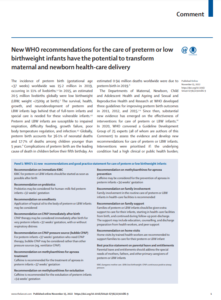
The incidence of preterm birth (gestational age <37 weeks) worldwide was 15.2 million in 2019, occurring in 11% of livebirths. In 2015, an estimated 20.5 million livebirths globally were low birthweight (LBW; weight <2500g at birth). The survival, health, growth, and neurodevelopment of preterm and LBW infants lags behind that of full-term infants and special care is needed for these vulnerable infants. Preterm and LBW infants are susceptible to impaired respiration, difficulty feeding, growth failure, poor body temperature regulation, and infection. Globally, preterm birth accounts for 36.1% of neonatal deaths and 17.7% of deaths among children younger than 5 years. Complications of preterm birth are the leading cause of death in children before their fifth birthday. An estimated 0.94 million deaths worldwide were due to preterm birth in 2019.
The Departments of Maternal, Newborn, Child and Adolescent Health and Ageing and Sexual and Reproductive Health and Research at WHO developed three guidelines for improving preterm birth outcomes in 2011, 2012, and 2015. Since then, substantial new evidence has emerged on the effectiveness of interventions for care of preterm or LBW infants. In 2020, WHO convened a Guideline Development Group of 25 experts (all of whom are authors of this Comment) to assess the evidence and develop new recommendations for care of preterm or LBW infants. Interventions were prioritised if: the underlying condition had a high clinical or public health burden; guidance was non-existent or conflicting; new evidence was likely to change or update recommendations; or if a recommendation would lead to an important change in clinical practice or programme design across countries. 17 new systematic reviews were commissioned and 21 additional existing systematic reviews and meta-analyses were assessed. Recommendations were based on effects (benefits and harms) on preterm or LBW infant outcomes, certainty of the evidence, the values of families and health workers, acceptability, resource requirements, feasibility, and equity.
On Nov 15, 2022, WHO published the outcomes of this process in the WHO Recommendations for Care of the Preterm or Low Birthweight Infant. There are 11 new recommendations and one new best practice statement (panel 1) that reflect a fundamental change in the way care for mothers and their newborn infants is conceptualised and should be provided in the future.